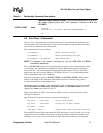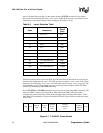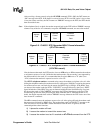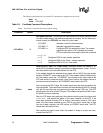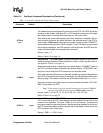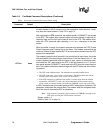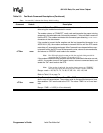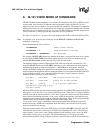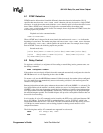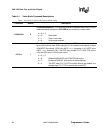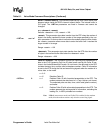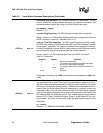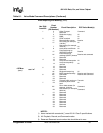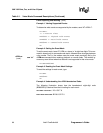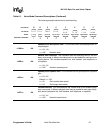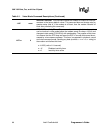
56K V.92 Data, Fax, and Voice Chipset
Programmer’s Guide Intel Confidential 81
6.1 DTMF Detection
DTMF detection information is handled differently than other detection information. IS-101
specifies that more than one <DLE><DTMF CHAR> character pair may be sent for a single DTMF
tone burst. As such, the modem sends delimiter <DLE> character pairs to indicate the end of a tone
burst. When a DTMF tone is detected in playback or command mode, the modem sends
<DLE><DEL> to indicate the end of a burst. For example, from a single burst of DTMF 5 tones, the
following reports are possible:
Playback and voice command modes:
<DLE><5><DLE><DEL>
When a DTMF tone is detected in the record mode, the modem sends <DLE></> to indicate the
beginning of a tone burst. The modem may then send one or more <DLE><DTMF CHAR> character
pairs followed by <DLE><DEL>, which signifies the end of the tone. For example, from a single
burst of DTMF 5 tones, the following reports are possible:
Record mode only:
[voice data]<DLE></><DLE><5>[voice data]<DLE><DEL>[voice data]
[voice data]<DLE></><DLE><5>[voice data]<DLE><5>[voice da-
ta]<DLE><DEL>[voice data]
6.2 Relay Control
To originate a call (that is, to originate call forwarding or auto-dialing) and to generate tones, use
the dialing command:
ATDT <telephone number>
If the modem was not already off-hook, then this command automatically configures the value for
AT+VLS=n to n=1 or n=5 depending on the value for Mn.
To answer a call, use the AT+VLS=n command. Unlike data mode, the modem (when configured
for voice mode) does not automatically answer an incoming call (that is, the modem ignores the
contents of S-register S0).
Remote playback/record takes place whenever the modem is off-hook (OHREL* is activated). For
local playback/record, the modem is on-hook, and the user uses a local telephone or handset. The
LPHREL* relay driver may be used to control the local telephone or handset when implementing
local playback/record mode (AT+VLS=n). Additionally, voice messages may be played through
the modem/computer speaker. The FastPath chipsets also provide a microphone interface that can
be used for local recording.
In voice mode, all voice AT commands can be issued by the DTE at any valid speed between 300
bps to 115,200 bps. Typically, the DTE-to-modem data rate is set for 19,200 bps, which is the
recommended data rate for Class 1 fax mode. The DTE-to-modem data rate may need to be set to
115,200 bps in certain instances, such as during playback or during record mode for a CL1
compression scheme.
The following data and fax AT commands are supported in voice mode:
Data: All except ATA, ATIn
Fax: +FCLASS



